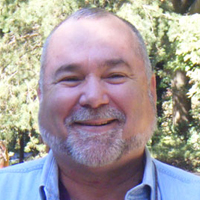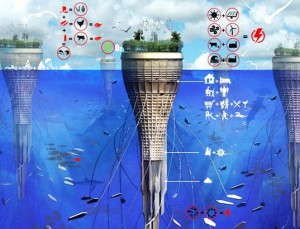
As Wyoming plans for federal collapse (where, exactly, they will put the aircraft carrier remains unresolved), it behooves all of us to spend a little time thinking about “what if” the national supply chains for food and fuel implode.
I am not that enthused about the terms “smart city” or even “intelligent city,” but recognize both among the links below. Neither smart nor intelligent equates to agile, adaptive, resilient, or sustainable.
In the course of my cursory evening of exploration, the coolest term I found was “future-proofing,” and here is the title and link to the online lecture, “Future Proofing Cities: Planning and Designing for Future Resilience” (Craig Applegath).
Runner-up terms included the “self-sufficient city,” “off-the-grid city,” and “living architecture.”
Intelligent City
Intelligent Cities (Book). With contributions from experts in research, design, and technology, the Intelligent Cities book offers an interdisciplinary look at the complex relationship between city form and technology. This wide-ranging and readable book summarizes the National Building Museum’s year-long Intelligent Cities initiative, which was an exploration of how data and information technology impact the way cities look, feel, and function.
Intelligent Cities (Expo). Intelligent Cities Expo has been postponed until we can find the right date window that allows for maximum participation. As we continue to develop this highly valuable and international forum, we greatly value your input.
Intelligent Cities (Web Page). Potpourri. Note: information technology does not a smart or intelligent city make. That is a bastardization of the concept. The fuller concept is better reflected in off-the-grid, self-sufficient, and resilient.
Off the Grid City
Competition seeks to build first city block that runs off the grid. Imagine an entire city block that operates off the grid. That’s what competitors were asked to do in Re:Vision Dallas, an international design competition that seeks to transform a neglected urban block in downtown Dallas into a self-sustaining community. The competition, which drew hundreds of entries from 26 countries, resulted in three winners, from which one will be chosen for construction later this year.
How Washington County Can Save Maine. With its strong and dependable tides and wind that blows hard almost every day, coastal Washington County has enough kinetic energy to power itself and then some.
New cities: off the grid and thinking locally. As Local Power: Tapping Distributed Energy in 21st-Century Cities points out, distributed energy calls for generating power locally and maximizing energy efficiency. All of this in the U.S. will require the creation of new financing mechanisms, a genuine public and private partnership, political leadership, and an informed citizenry.
Nick Rosen’s Off-The-Grid Community Vision. Imagine an enormous intentional community of 2,000 residents, all living sustainably off-the-grid. This is what Nick Rosen is noodling over since working on his book, ![]() Off the Grid
Off the Grid.
Resilient City
Architectural Review 123: The Resilient City. As many of the world’s cities groan under the strain of unprecedented urban sprawl, the current issue of Architectural Review Australia explores the concept of ‘resilience’ in architecture and urban design.
Resilient cities – Responding to Peak Oil and Climate Change. First, they confront the problems, describing where we stand today in our use of oil and our contribution to climate change. They then present four possible outcomes for cities: ”collapse,” “ruralized,” “divided,” and “resilient.” In response to their scenarios, they articulate how a new “sustainable urbanism” could replace today’s “carbon-consuming urbanism.” They address in detail how new transportation systems and buildings can be feasibly developed to replace our present low efficiency systems. In conclusion, they offer ten “strategic steps” that any city can take toward greater sustainability and resilience.
Financing the Resilient City. A Think Tank on “Financing the Resilient City” composed of twenty experts was convened by ICLEI in Bonn/Germany from 10-12 February 2011. Participants brought to the table expertise from local governments, city networks, private financial services, development banks, development agencies, United Nations agencies, and foundations.
ResilientCity.org. ResilientCity.org is an open, not-for-profit network of urban planners, architects, designers, engineers, and landscape architects whose mission is to develop creative, practical, and implementable planning and design strategies that help increase the capacity for resilience of our communities and cities to the future shocks and stresses associated with climate change, environmental degradation, resource shortages, in the context of global population growth.
Urban Hazard Mitigation: Creating Resilient Cities. Cities are complex and interdependent systems, extremely vulnerable to threats from both natural hazards and terrorism. This paper proposes a comprehensive strategy of urban hazard mitigation aimed at the creation of resilient cities, able to withstand both types of threats. The paper reviews hazard mitigation practice, defines a resilient city, considers the relationship between resilience and terrorism, and discusses why resilience is important and how to apply its principles to physical and social elements of cities. Contending that current hazard mitigation policy, practice, and knowledge fail to deal with the unique aspects of cities under stress, the paper recommends a major resilient cities initiative, including expanded urban systems research, education and training, and increased collaboration among professional groups involved in city building and hazard mitigation.
What Makes a “Resilient City”? Renewable energy, carbon neutral, distributed, photosythetic, eco-efficient, place-based, sustainable transport. 11 design principles.
Self-Sufficient City
Herbert Girardet: The self-sufficient city. The characteristic of a truly sustainable city is, first and foremost, that it powers itself entirely by means of renewable energy systems. Herbert Girardet encourages us to make a quick switch to renewable energy to power our houses, our urban transport systems and our daily way of life.
Self-sufficient city of the future for China. This is the new projects from SBA Design’s, a futuristic new city. Dubbed “Glo-cal DNA”, the self sufficient, low carbon, mixed-use development is slated for construction on Hainan Island – a pumping 42.6 square kilometer tourist hotspot.
The Self-Sufficient City. The projects feature multi-level landscapes (green roofs, vertical planting and farming), circular cradle-to-cradle systems for waste products to become resources, and emphases on mixed-use spaces such as public parks that also function as grazing fields for livestock.
The Self-Sufficient City: On Ecological Design and Urbanism. It requires fuel to live, expels waste as byproduct, grows and shifts, hosts other organisms. It can be sick and recede, or it can thrive and expand. We, as the City dwellers, depend on its health and vibrancy just as we, too, seek to sustain and to perpetuate our own lives. Working together, we can renew the place of our dwelling, form an environment of balance of action and consequence, cause and effect. Resources Lost may be Found again.

Underwater Skyscraper is a Self-Sufficient City at Sea. Ocean levels are rising around the globe, so rather than tethering our buildings to the sinking shoreline why not suit them for a life at sea? That’s the approach behind the Water-Scraper, a futuristic self-sufficient floating city. A special mention in the eVolo Skyscraper Competition, the design expands the concept of a floating island into a full-fledged underwater skyscraperthat harvests renewable energy and grows its own food.
Smart City
Smart Cities 2012 (Conference). IMAGINE tomorrow’s intelligent infrastructures, today. LEARN about smarter transport, energy and water technologies. DEVELOP a sustainable smart city planning strategy. BUILD citizen engagement to create long-term change
Smart-Cities.net. SMART-Cities refers to Sustainable Management Action Resource Tools for Cities. The site contains “City Pages” and “Green Pages“, with information on cities and companies' databases, search function, and interactive communication and matching tools.
Smart City Model. Smart Economy, Smart Environment, Smart Governance, Smart Living, Smart Mobility, Smart People. 6 characteristics, 31 factors, 74 indicators.
Sustainable City
Sustainable Cities (Appropedia). A sustainable city can feed and power itself with little reliance on the surrounding countryside, and creates the smallest possible ecological footprint for its residents. This is friendly to the surrounding environment, with negligible pollution, low-impact land use, and alleviation of climate change.
Sustainable Cities (Siemens). Our longstanding expertise has given rise to innovative technology for sustainable solutions in energy efficient buildings, water treatment facilities, transportation infrastructure, public safety systems and healthcare imaging and diagnostics.
Sustainable-City.org [San Francisco]. Air Quality; Biodiversity; Energy, Climate Change and Ozone Depletion; Food and Agriculture; Hazardous Materials, Economy and Economic Development; Environmental Justice; Human Health; Municipal Expenditures; Parks, Open Spaces, and Streetscapes; Public Information and Education; Risk Management (Activities of High Environmental Risk); Solid Waste; Transportation; Water and Wastewater.
What is a Sustainable City? The most widely known definition of sustainable development comes from the Brundtland Commission, which defined sustainable development as “development that meets the needs of the present without compromising the ability of future generations to meet their own needs.”



